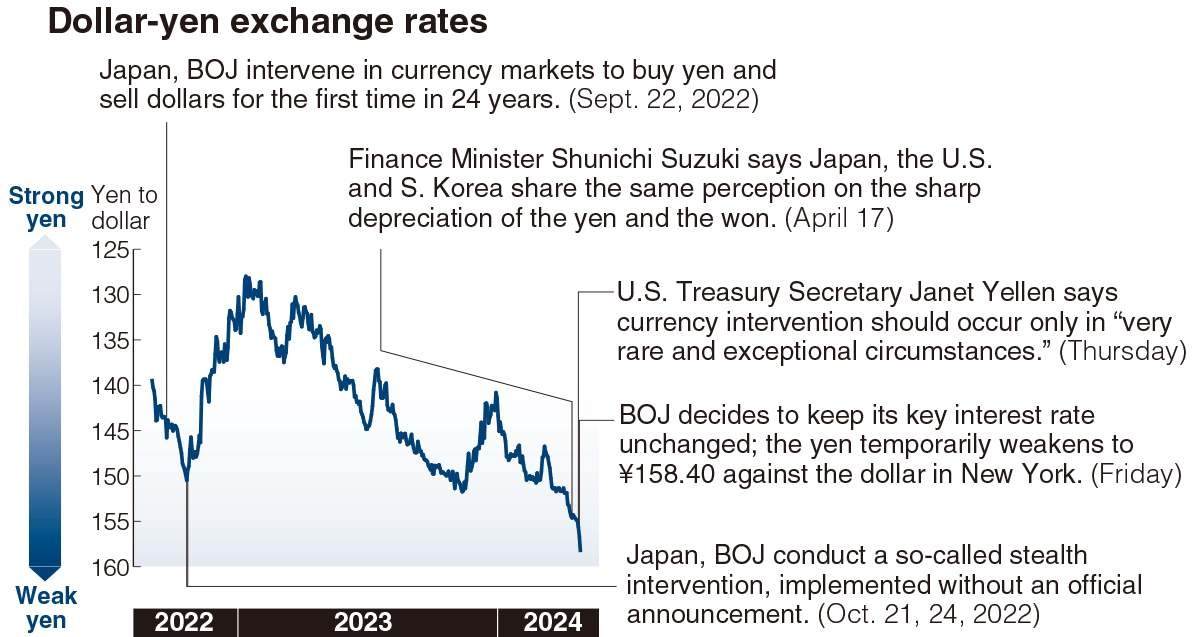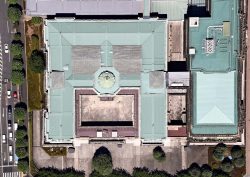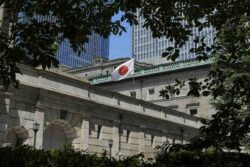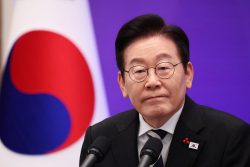Japanese Government, BOJ Refrain from Intervening in Foreign Exchange Markets Despite Record Fall in Yen’s value

A large monitor shows the yen-dollar exchange rate in New York hitting ¥158 in Shibuya Ward, Tokyo, on Saturday afternoon.
19:19 JST, April 28, 2024
The yen has fallen to a historic low against the U.S. dollar, yet the government and the Bank of Japan have observed without intervening.
The yen’s fall reached the ¥158.40 range in the New York foreign exchange market on Friday, marking its weakest level in about 34 years. Business leaders are among those who have called for measures to correct the decline of the yen’s value.
“The yen’s fall has so far not impacted largely on the fundamental rate at which prices increase,” said BOJ Gov. Kazuo Ueda at a press conference Friday afternoon.
He made no strong efforts to check the yen’s decline, which has led decisively to a market trend of selling the yen and buying the dollar.
As many market players expected, the BOJ decided to maintain its current monetary policy. Those same players thought that Ueda would suggest quickly implementing an additional interest rate hike. If the yen remains weak in the long term, prices will be at risk of rising at a rate higher than the 2% that the central bank sees as a stable inflation target, and a rise in the costs of raw materials caused by such a price increase could cause consumer spending to stagnate.
However, Ueda’s remarks at the press conference were taken to mean that the BOJ will tolerate the current situation. Consequently, just half a day after his press conference ended, the yen fell by more than ¥1.50 in New York markets.

Defense line
The government and the BOJ’s efforts to intervene in the market by buying the yen and selling the dollar has given rise to a sense of caution in the market, and a sense of uncertainty has increased with it.
In September 2022, the first yen-buying intervention in 24 years was conducted right after a press conference for the central bank’s Monetary Policy Meeting with then BOJ Gov. Haruhiko Kuroda.
In October 2022, market intervention came again after the yen fell to a rate of ¥151.90 against the dollar. Thus, market players assumed that ¥152 against the dollar was the government’s “defense line.”
This time, however, no signs of intervention were observed following Ueda’s press conference. The rate of ¥155 against the dollar was assumed to be another defense line, but even as the yen fell far below that line, Japan did not intervene.
Statements from Cabinet members have also changed.
On March 27, when the dollar climbed as high as ¥152, Finance Minister Shunichi Suzuki issued a warning to speculators, saying, “We’ll take decisive action against any excessive moves,” and the yen-dollar exchange rates somehow stabilized.
On April 17, the finance ministers of Japan, the United States and South Korea held a meeting and said in a joint statement that they “acknowledge the serious concerns” of Tokyo and Seoul over the recent sharp depreciation of the yen and the won. The statement was perceived as “groundwork” for market intervention.
But on April 25, a week later, U.S. Treasury Secretary Janet Yellen told Reuters that currency intervention should occur only in “very rare and exceptional circumstances,” throwing cold water on market speculation.
Suzuki toned down his previous statements at a press conference after a Cabinet meeting Friday: “We will closely monitor developments and implement all possible measures.”
Timing, scale
The business community has also voiced concerns about the excessive depreciation of the yen.
Speaking at a press conference on Friday, Takeshi Niinami, chairperson of the Japan Association of Corporate Executives, known as Keizai Doyukai, said that the nation was moving toward ‘good price growth,’ in which the economy is stimulated by wage increases that outpace prices among other factors, but warned that the weak yen may get in the way.
“I would describe the yen’s depreciation as extraordinary. I’m concerned that the national strength of Japan itself is at risk. I hope that the foreign exchange market will normalize,” NEC Corp. President Takayuki Morita said Friday.
Since it is unlikely that the BOJ will shift suddenly and restrict lending through additional rate hikes or other policies, virtually the only way to halt the rapid depreciation of the yen is currency intervention.
But Japan seems to be considering the timing and scale required for the intervention to produce a large enough effect, since the trend of selling the yen and buying the dollar cannot be changed given the wide interest rate gap between the United States and Japan.
Takahide Kiuchi, executive economist at Nomura Research Institute Ltd., said, “The government is required to demonstrate to businesses and the public that it’s taking action to prevent the yen from weakening, and it remains highly likely that it will intervene the market.”
"Business" POPULAR ARTICLE
-

Tokyo Economic Security Forum to Hold Inaugural Meeting Amid Tense Global Environment
-

Keidanren Chairman Yoshinobu Tsutsui Visits Kashiwazaki-Kariwa Nuclear Power Plant; Inspects New Emergency Safety System
-

Imports of Rare Earths from China Facing Delays, May Be Caused by Deterioration of Japan-China Relations
-

University of Tokyo Professor Discusses Japanese Economic Security in Interview Ahead of Forum
-

Japan Pulls out of Vietnam Nuclear Project, Complicating Hanoi’s Power Plans
JN ACCESS RANKING
-

Tokyo Economic Security Forum to Hold Inaugural Meeting Amid Tense Global Environment
-

Keidanren Chairman Yoshinobu Tsutsui Visits Kashiwazaki-Kariwa Nuclear Power Plant; Inspects New Emergency Safety System
-

Imports of Rare Earths from China Facing Delays, May Be Caused by Deterioration of Japan-China Relations
-

University of Tokyo Professor Discusses Japanese Economic Security in Interview Ahead of Forum
-

Japan Pulls out of Vietnam Nuclear Project, Complicating Hanoi’s Power Plans



























